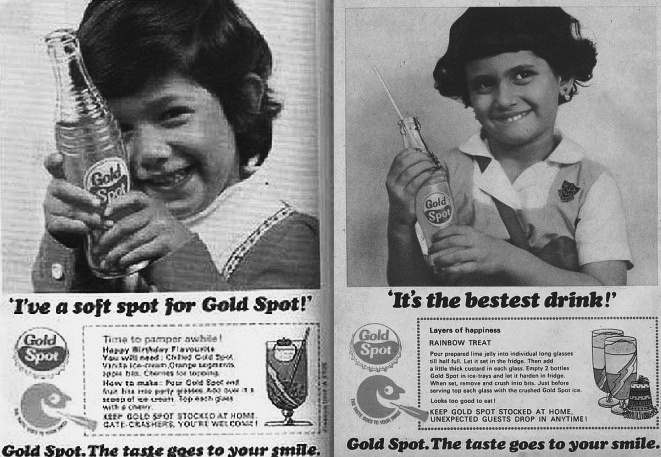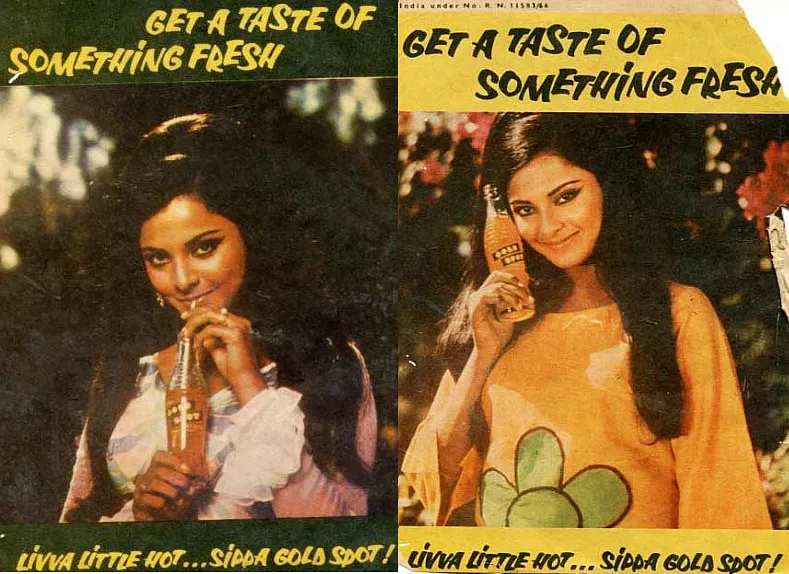Gold Spot – The Uncola Which Had A Zing

Gold Spot was the most popular “Uncola” of its time in India because of the advertising and the ‘Zing’ it spoke about
In the late 1940s, when the Parle company, founded by the Chauhans, was thriving because of the popularity of its “Parle Gluco” glucose biscuits. The company then experimented with a new brand/product. Gluco Cola was introduced in 1949 when the company chose to enter the cola industry by relying on the success of its “Gluco” brand. R K Laxman, the great cartoonist, created the campaign. The brand seemed like it was going to do well, but just a few weeks after it started, Coca-Cola sued it over its name. After fighting for two years in court, Parle finally gave up and stopped making “Parle Cola” (it was renamed) in 1951.
Parle, though, was not the kind to give up on its goals so quickly. Gold Spot, a carbonated orange drink, was introduced in 1952 and named after the company’s successful Parle Gold Star peppermint product.
The fact that it retained its taste when slightly cold made it an immediate success. To keep the bottles cold, vendors would transport them in huge dishes filled with ice and sell them at high foot traffic areas, beaches, and other tourist destinations.
Gold Spot was known to be a children’s brand. There was a mad dash to get the Gold Spot bottle caps with collector cartoons inside. There was a competition among the youngsters to see who could amass the most bottle caps.

Starry
They highlighted a flirtatious Rekha in the early 1970s as a South Indian actress on the verge of breaking into Hindi film to appeal to a younger audience. Looking at the rushes, Kersey Kartak said, “Wow, I’m going to write a line for this” which eventually became the slogan “Livva bit hot, Sippa Gold Spot.”
Kakkar, then a young assistant, was working on the set of the commercial for the first time. Both Shyam Benegal and Govind Nihalani, the film’s cinematographer, went on to work together in the future to create films for India’s “parallel cinema” movement. Rekha was casually strolling along the beach as Usha Uthup sang.
Television was just getting started and posters were the main form of advertising. The ads were blown onto walls and boards and splattered on newspapers and magazines. Osho even made fun of the advertisement, saying, “If you read that too many times—”Livva little hot, Sippa Gold Spot,”—one day you will sip Gold Spot!” in response to a question about a rogue memory.

Nonetheless, the brand’s primary demographic remained kids. Its popularity was bolstered by the inclusion of kid-friendly features like collections and games.
The next step
ASP, an advertising firm, created subsequent commercials for the beverage after officials warned that a flavouring component may cause cancer. The company decided that, in addition to the chemical modifications, marketing the product as the “new” Gold Spot would be the best way to silence critics of the drink.
The team, led by master ad filmmaker Prahlad Kakkar, came up with many scenarios, such as a graduation and a wedding night, in which they would ask, “Have you tried the new Gold Spot?” during the dramatic climax. However, as shooting came to a close, Kakkar tried something different. He secretly requested that a “vague funny-looking man” from the workplace take cover behind a table, who strolled up to the counter as the cameras were rolling and said, “Can I have a Limca?”
An immediate answer of “Shut up stupid, this is a Gold Spot film,” was given.
Ramesh Chauhan was not an easy man to persuade. Even though Limca was another one of his beverages, traditional advertising conventions remained fast. K Kurien, a senior, convinced him, and after it aired, there was a huge buzz.
A lot of pressure had been put on Gold Spot as it was strongly identified as a kid-favourite before the ‘The Zing Thing’ commercials started airing.
The pivot
Around the middle of the ’80s, Gold Spot realised it needed to pivot. It was trying to grow by appealing to young people. The brand was given to Rediffusion with the instruction that it should stop being associated with children.
There was a tingling at the end of each sip of Gold Spot, and its flavour profile included a sugary tang and a strong orange aroma and flavour. The famous copywriter Kamlesh Pandey came up with the phrase “The Zing Thing” rather grudgingly.
Prahlad Kakkar, Louis Banks, and the Rediffusion team wanted to create commercials that mirrored the tone of the 1978 film Grease, so they came up with the slogan and the idea of featuring hip, young people engaging in carefree activities like dancing, roller skating, and driving to upbeat Western-influenced tunes.
The jingle’s basic message was as follows: “He is crazy about me, and she is crazy about me, and both are as crazy as they are for Gold Spot, the Zing Thing..” The lyrics of the music were designed to convey: The flavour is so magnificent but so familiar, that it summoned the best and the worst in you.
Rediffusion’s advertising had a seismic effect. Zing became a slang term meaning “sexy” or “hot.” Drinking it was a way to distinguish yourself as a member of the disco and dance community. As far as its day and age go, it was a total success.
Gold Spot was the most popular “Uncola” of its time in India because of the advertising that portrayed it as the “for me” brand among young people in the nation.
The Los Angeles band Gold Spot supposedly got their name from this fizzy beverage. One of the interviews with Gold Spot’s key member, Siddhartha Khosla, reveals the band’s widespread acclaim in India at the time.
According to reports, Parle sold out to Coke for $40 million when the “cola wars” resumed in full force with the introduction of Pepsi in 1990 and the return of Coca-Cola in 1993.
As soon as Sprite and Fanta were introduced, Coca-Cola pulled the plug on Gold Spot.
Reference
https://www.campaignindia.in/video/a-gold-spot-for-your-memories/470587



